Bakar's Kukuljanovo Industrial Zone Most Well-Equipped in Country
December the 12th, 2022 - Bakar's Kukuljanovo industrial zone spans approximately 500 hectares and is by far the largest and best-equipped zone of its kind in all of Croatia.
As Poslovni Dnevnik/Darko Bicak writes, with the final complete infrastructural arrangement of this part of the Kukuljanovo industrial zone, including the accompanying newly asphalted roads and public lighting, the zone in every part of it is set to become of equal quality and attractive, including for potential new investors.
Bakar's Kukuljanovo industrial zone, spanning the aforementioned area of about 500 hectares, i.e. five million square metres, is the largest and, as they say, the most well-equipped such zone in all of Croatia. The proximity of the Port of Rijeka and the position on the motorway to the south, but even more significantly towards Zagreb and the whole of Central and Eastern Europe, are certainly this impressive zone's trump cards.
In the immediate vicinity of Kukuljanovo lies Rijeka Airport on the island of Krk, and although there has been an enormous amount of interest among entrepreneurs and business owners in working in and around this area for years, there are still around 200 hectares sitting entirely vacant in IZ Bakar, which are constantly being arranged and prepared for new tenants. Currently, more than 200 business entities with around 4,500 employees have positioned themselves on the Kukuljanovo industrial zone. There is also a free customs zone with an area of 100 hectares in this area.
The price of the land, which is being sold as a plateau at a public tender, ranges from 55 to 100 euros per square metre. The zone is constantly expanding. Just last year around 28,400 square metres of space were bought, and for this year the plan to buy another 30,000 square metres worth 5.8 million kuna in total. Revenues throughout 2022 are planned at the level of 17 million kuna, which is only 54% of the realisation from the record year of 2021.
Spatially speaking, the zone is divided into its western part, which is mostly built up, and the eastern, significantly less developed part, which is located in the wider circle of the Zlanjevo lagoon. These two spatial areas of the Kukuljanovo industrial zone are crossed by the local road called 58110, which connects the village of Kukuljanovo with the Municipality of Cavle. The existing roads in the eastern part of the zone (ex R 29/I) haven't yet been completely finished with the final wearing layer of asphalt and a suitable sidewalk.
Therefore, the City of Bakar itself, based on the contract for the maintenance of ungraded roads, carried out the ''revamp'' of the existing bearing layer of the pavement, the rehabilitation of rainwater drainage covers, the reconstruction of all drains, the replacement of all road and park curbs, the installation of the final asphalt layer of the pavement and the rehabilitation of asphalt on the pavements. Tactile panels have been installed along the pavements to make it easier for blind and visually impaired people to find their way around. The total value of the works stood at a massive 4.03 million kuna, and the contractor was Ceste Rijeka (Rijeka Roads). The length of the renovated pavement is 2,600 metres.
Perhaps the most famous ''name'' that opened a business premises on the Kukuljanovo industrial zone this year is Hrvatska posta (Croatian post), which opened a new logistics and distribution centre worth 60 million kuna back during the middle of March, which employs around 300 employee. The largest individual space in the zone is held by the Port of Rijeka with the Skrljevo Terminal, which is a back-end multipurpose logistics centre intended for the handling and storage of containers, general and bulk cargo, and even wood. It spans a total area of 440,000 square metres, of which 55,000 square metres are confined warehouses. The terminal has the status of a free customs zone.
For more, make sure to check out our news section.
Croatia’s Most Spectacular Vineyard: Sea, Stone and Sparkling Wine of Bakar Bay
March 4th, 2022 - For centuries, the steep slopes of Bakar bay have been covered in terraced vineyards built in dry stone. A look into the iconic sparkling wine Bakarska Vodica and the passionate local community that rekindled the tradition and saved the brand from oblivion
There’s a small town in the Northern Adriatic that once used to be three times as big as the capital. In terms of population, that is: at the turn of the 19th century, Bakar was the most populated town in Croatia.
A lot has changed since then, including the landscape of the once idyllic coastal town. In the 1970s, the Bakar bay was transformed into an industrial zone featuring a coke plant and a bulk cargo port, complete with an oil refinery in the nearby Urinj. The plant closed down in the late 90s, but it took a lot longer for the town tainted by decades of pollution to shake off the stigma and focus on brighter things ahead.
 Bakar / TMaras, Creative Commons
Bakar / TMaras, Creative Commons
Looking at the remnants of Bakar’s industrial past lining the bay, you would never think that the area used to be known for prolific wine production. And yet it was, and even though the centuries-long winemaking tradition was briefly interrupted, the area is now regaining its fame thanks to the herculean efforts of the local community.
The story of Bakar wine begins in the 18th century, when Empress Maria Theresa granted Bakar the status of a free town complete with all related privileges. The empress encouraged the wine trade, going so far as to exempt those who cultivated the land for the purpose of grape growing from paying taxes for a period of five years.
The local populace jumped on the opportunity and the steep Bakar coastline soon turned into one big vineyard, but the specific traits of this geographic area meant that people had to get creative.
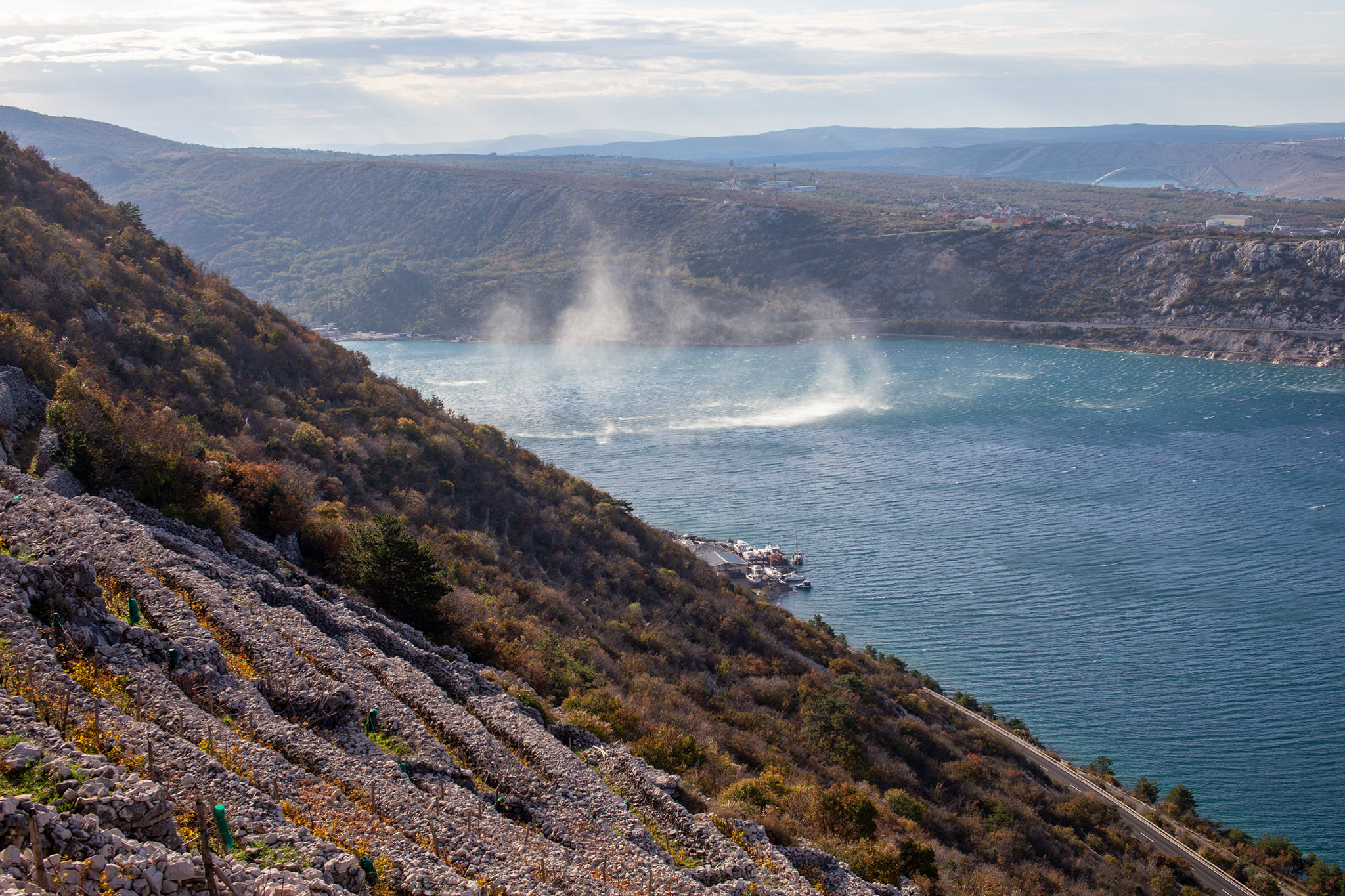 Praputnjak - kulturni krajolik Facebook
Praputnjak - kulturni krajolik Facebook
First of all, there’s bura. The mighty wind wreaks havoc in this part of the Adriatic to such a degree that it inspired a saying: bura is born in Senj, gets married in Bakar, and goes to Trieste to die. With a good part of the Bakar coastline fully exposed and facing the open sea, something had to be done to shield the grapevines from the wind’s destructive force.
There’s also the rugged karst terrain, not exactly the most favourable environment in terms of agriculture. The barren slopes had to be painstakingly cleared of stone and what little vegetation there was, followed by enrichment of the land with fertile soil brought over from the hinterland.
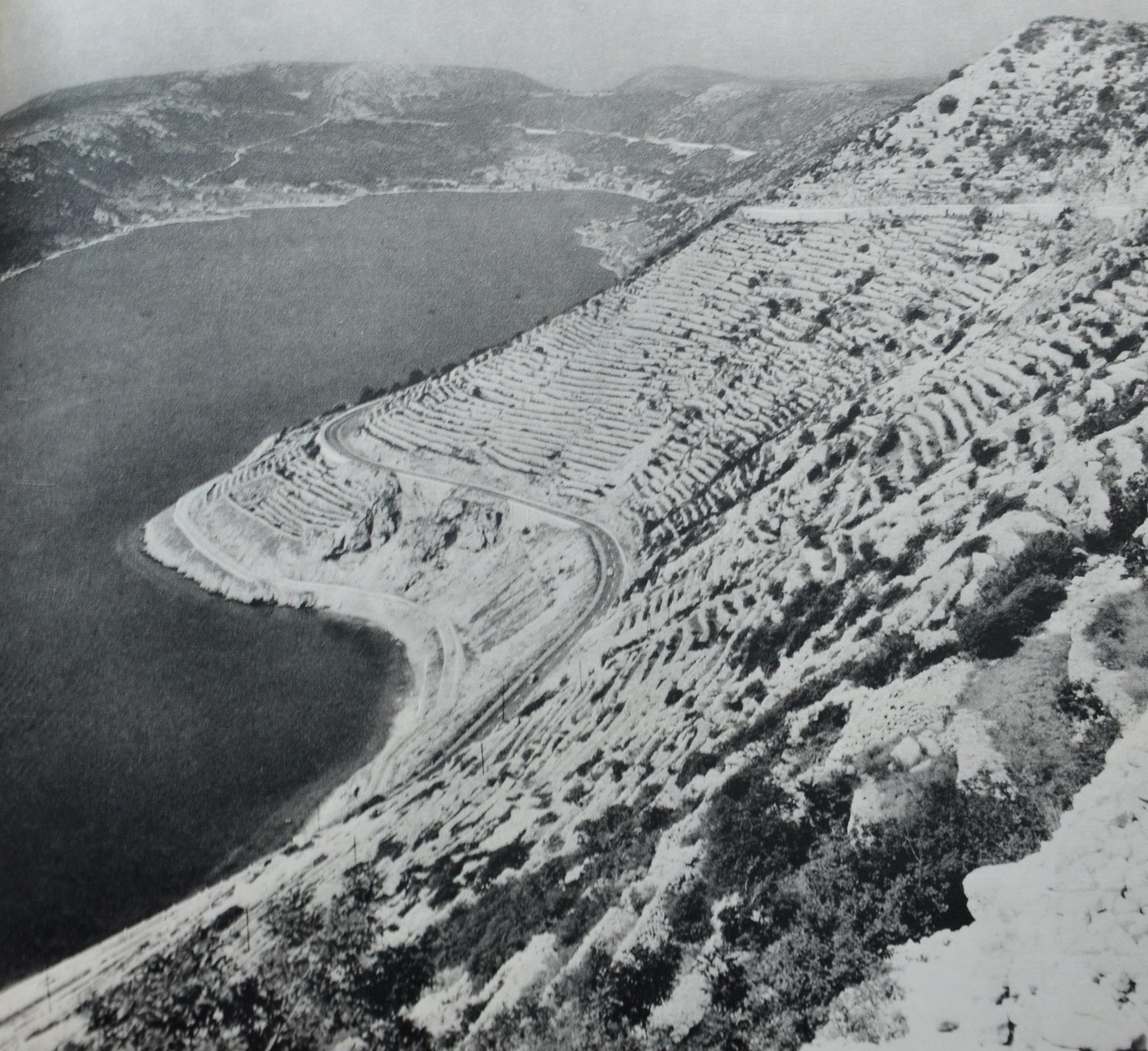
To ensure all of this stayed in place, the local population built dry stone walls, creating vast terraced vineyards that are known in Croatian as Bakarski prezidi. And while dry stone walling is a staple of traditional building in Croatia, rarely is it found in such a unique form: steep slopes criss-crossed with walls, running almost all the way down to the sea.
Given the challenging terrain, it took eight hours of work for one person to build 1,5 cubic metres of dry stone wall. Soil had to be brought over from the mountainous hinterland, either on foot or on carts, prolonging the construction process.
And yet, by the end of the 18th century, dry stone terraces covered 42 hectares of land on the Bakar coastline, entirely cultivated with grapevines. As seen from above, minus the grapes:
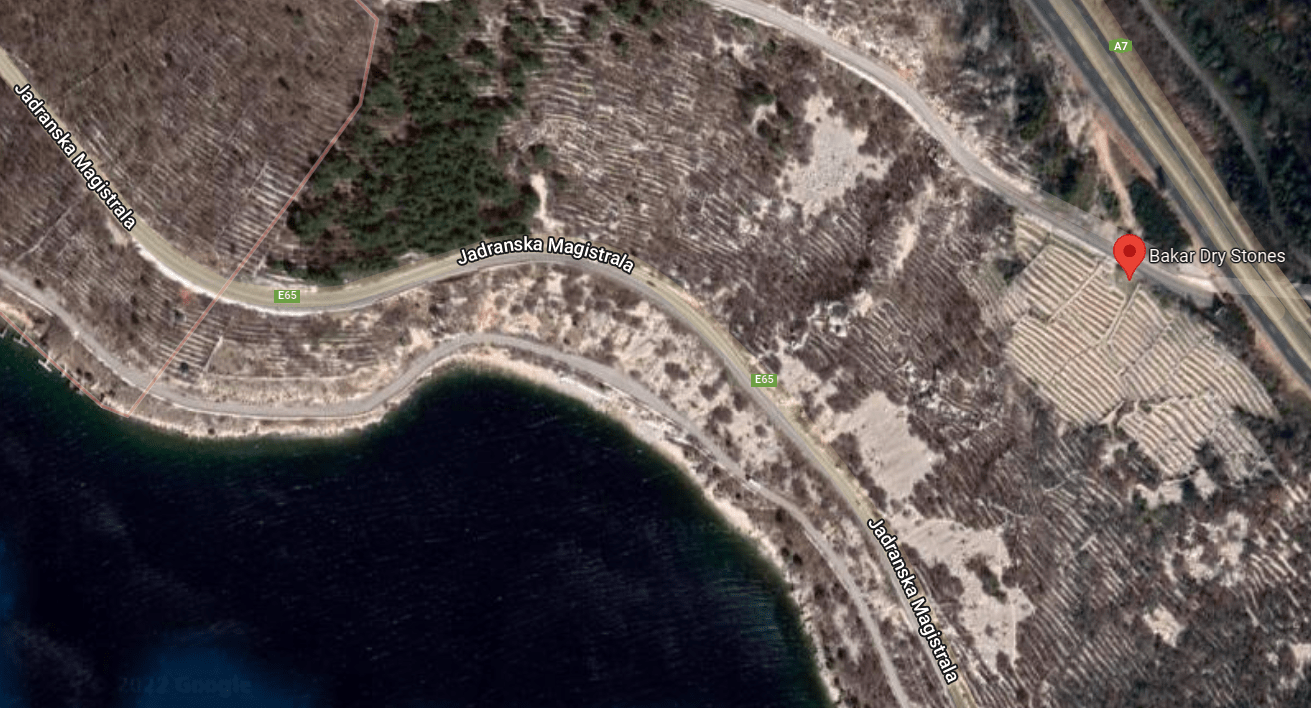 The dry stone walls of Bakar, with the most recently restored area seen on the right
The dry stone walls of Bakar, with the most recently restored area seen on the right
The local population, mostly that of the nearby village Praputnjak, grew the belina grape variety used to produce a renowned sparkling wine named Bakarska Vodica (Bakar Water).
It’s speculated that the methods of sparkling wine production were introduced in this region by French soldiers during the Napoleonic era, or perhaps by Bakar shipowners who at the time did business with France. Either way, it didn’t take long for winemaking to become one of the main sources of livelihood in the area. All the families in the region took part in the grape harvest, and the tricks of the trade were taught to children from an early age.
With most men employed at the local shipyards or out at sea for a good part of the year, women took on a lion’s share of the work and were proficient in every part of the wine trade, from cultivation to winemaking. Men typically took on the more physically strenuous tasks such as the construction and maintenance of the dry stone walls.
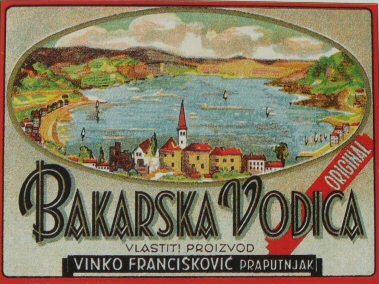 A vintage label design for Bakarska Vodica / Public domain
A vintage label design for Bakarska Vodica / Public domain
For centuries, Bakarska Vodica was produced in the Bakar region using the ancient method known as méthode rurale, which involves bottling the still-fermenting young wine so it would produce CO2 in the bottle without the need for a second fermentation process. It was made of indigenous white grape varieties, belina for the most part, as well as žumić, vrbić, verdić, žlahtina, gustošljen, brankovac and white muscat.
Bakarska vodica was historically held in high regard and was seen as a brand of the region. A wine law passed in 1930 reads:
The name Bakarska Vodica can only be used for natural sparkling wine produced in Bakar and its environs from grapes grown in the area and using the traditional method.
And:
Bakarska Vodica is a natural sparkling wine from the Croatian Littoral. The fermenting young wine (mošt) is bottled and stored in a cold environment.
Speaking of branding, the Bakar wine was talked about as early as 1910, with a state decree saying:
The name 'sparkling wine' is to be featured on bottle labels, printed in large and easily legible letters that draw attention. The label is to be affixed in such a way that it can only be removed from the bottle by being soaked in water.
Bakarska Vodica was not to be messed with. And so it went on until WWII, when production came to a halt for a number of reasons varying from grapevine diseases to legal regulations.
Its real fall from grace began in 1960, when the company Istravino adopted the name Bakarska Vodica for a low-quality sparkling wine made by carbonation and bastardised the poor historic brand. Over time, they reached an output of 2,5 million bottles a year, made possible by low manufacturing costs and partially outsourcing production to Slovenia. The faux Bakarska Vodica is still available on the market, nowadays produced by Mladina in continental Croatia.
This could have been the end of Bakarska Vodica, were it not for a passionate community of Praputnjak locals who decided to roll up their sleeves and reinstate one of the region’s most recognisable brands. In 2000, the Agricultural Cooperative Dolčina from Praputnjak (Poljoprivredna Zadruga Dolčina) launched an initiative to restore the old vineyards and save the belina variety from extinction.
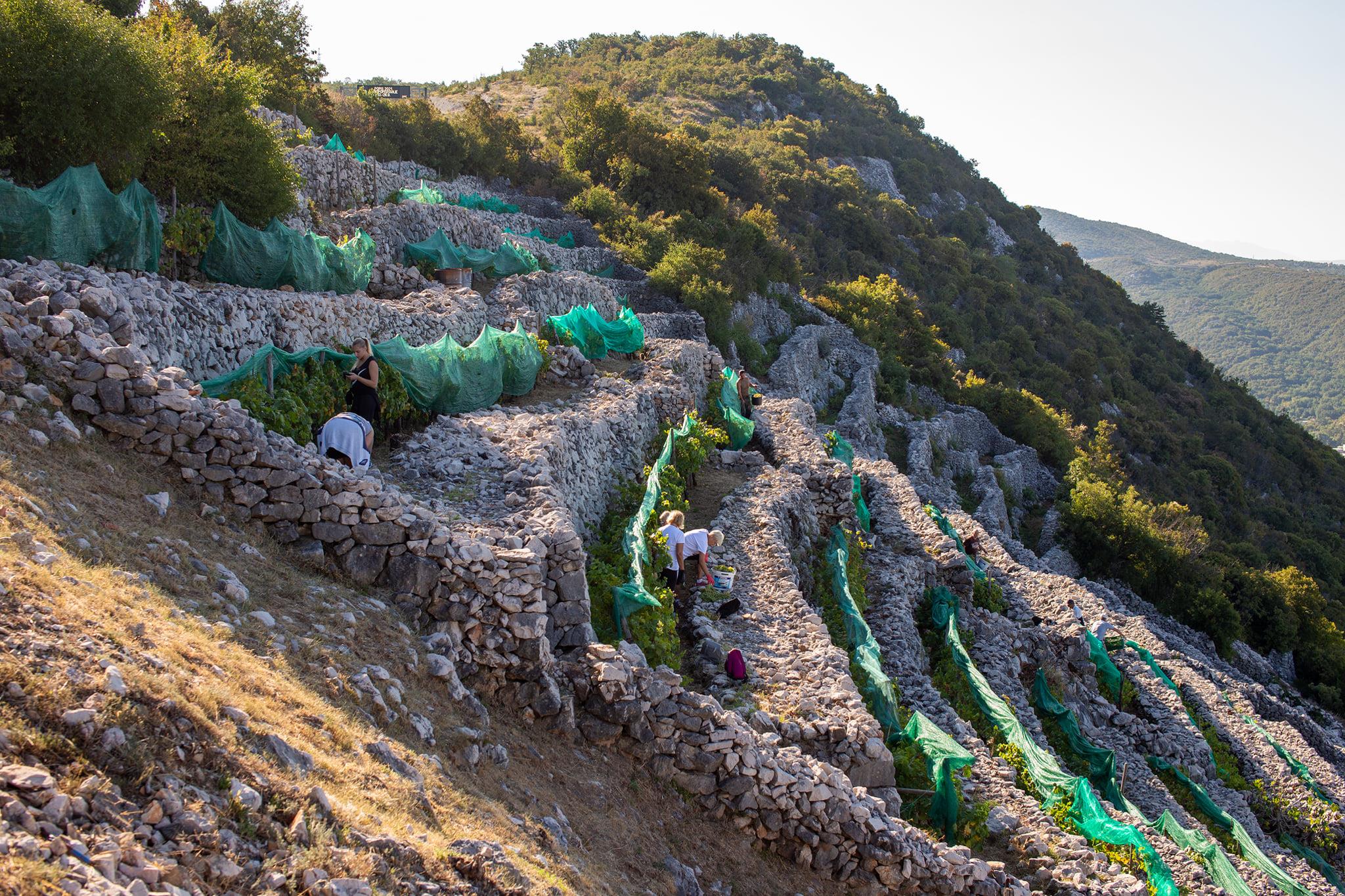 Praputnjak - kulturni krajolik Facebook
Praputnjak - kulturni krajolik Facebook
It made perfect sense to start at Takala, a location east of Bakar that the Ministry of Culture declared a protected cultural landscape (ethno zone) in 1972. Takala was historically cultivated by the people of Praputnjak, and the land plots are owned by the locals to this day. In the local dialect, the name Takala means ‘poured downhill’ - very appropriate in this context.
By 2002, eight dry stone terraces were restored, the land cleared after decades of neglect, and the first 280 belina seedlings ceremoniously planted before a delighted crowd. Little by little, the vineyard grew in size, soon yielding a large enough harvest for the famous bubbly to be reintroduced under the name of Stara Bakarska Vodica (Old Bakar Water).
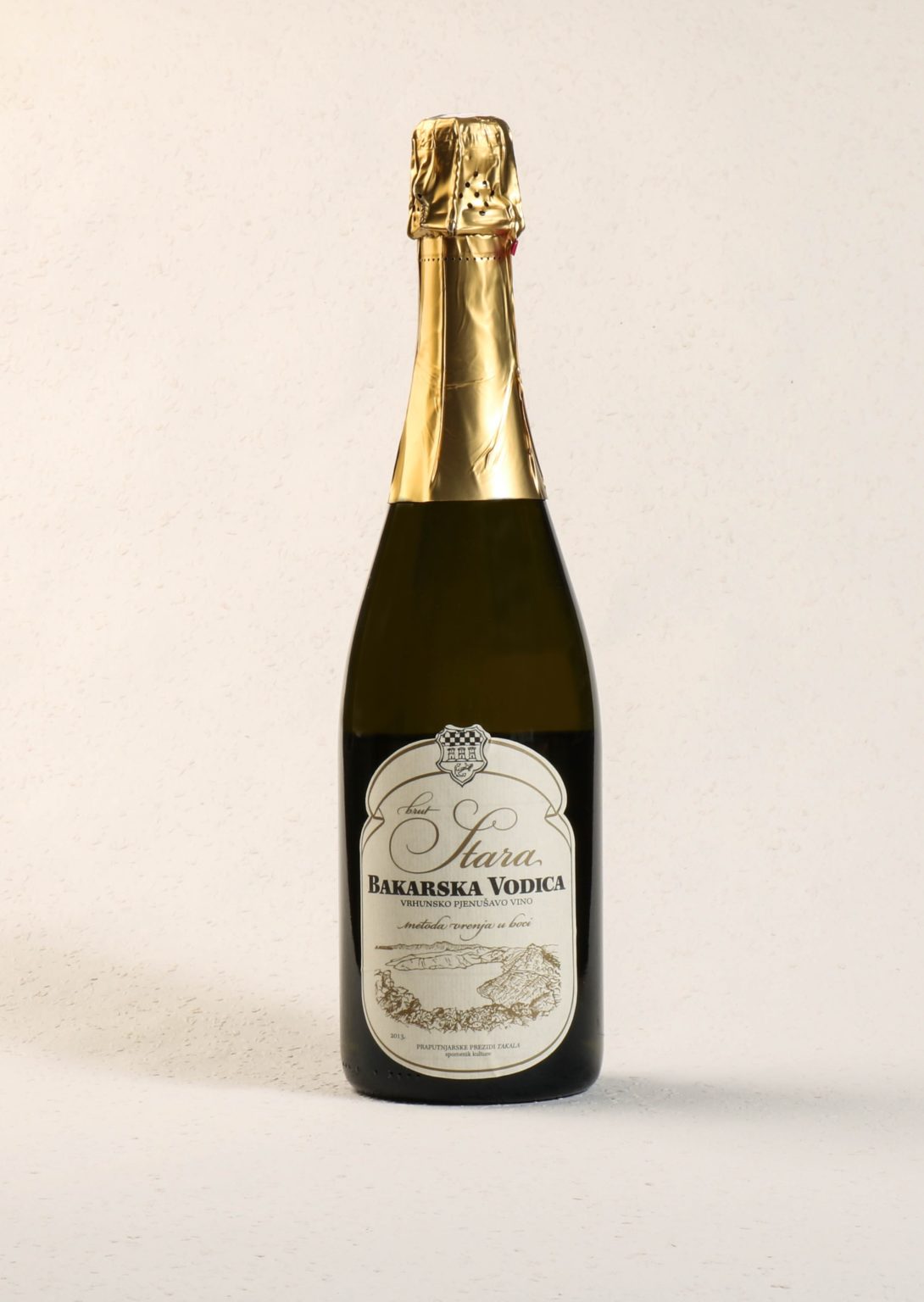 Stara Bakarska Vodica / Kašetica
Stara Bakarska Vodica / Kašetica
Fueled by unrelenting enthusiasm, the project marches on. It was made part of the Rijeka 2020 - European Capital of Culture programme as an initiative entitled Praputnjak - Cultural Landscape.
Together with the Dolčina association and the Dragodid project dedicated to preservation of dry stone masonry, the Praputnjak crew organise wall restoration workshops, with eager volunteers gathering to help rebuild the dry stone terraces. It’s all done by hand, as mechanisation isn’t an option given the specific terrain.
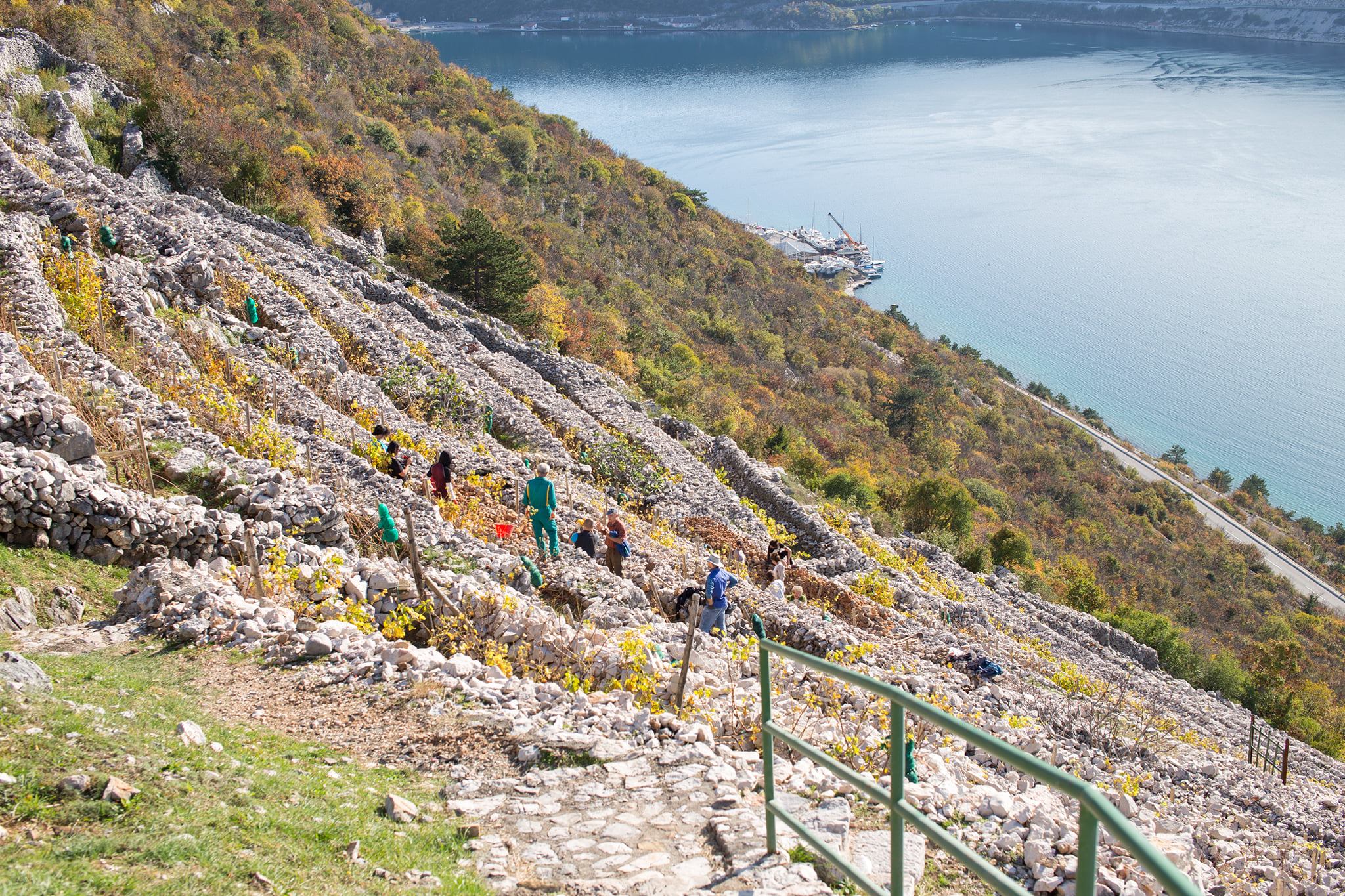 Praputnjak - kulturni krajolik Facebook
Praputnjak - kulturni krajolik Facebook
Nowadays, the Takala vineyard yields some 1,000 bottles of sparkling wine per year. There are no plans for mass production and the wine is not meant to become commercially viable; it’s purely an effort to rekindle the old tradition and save the heritage of the Bakar area.
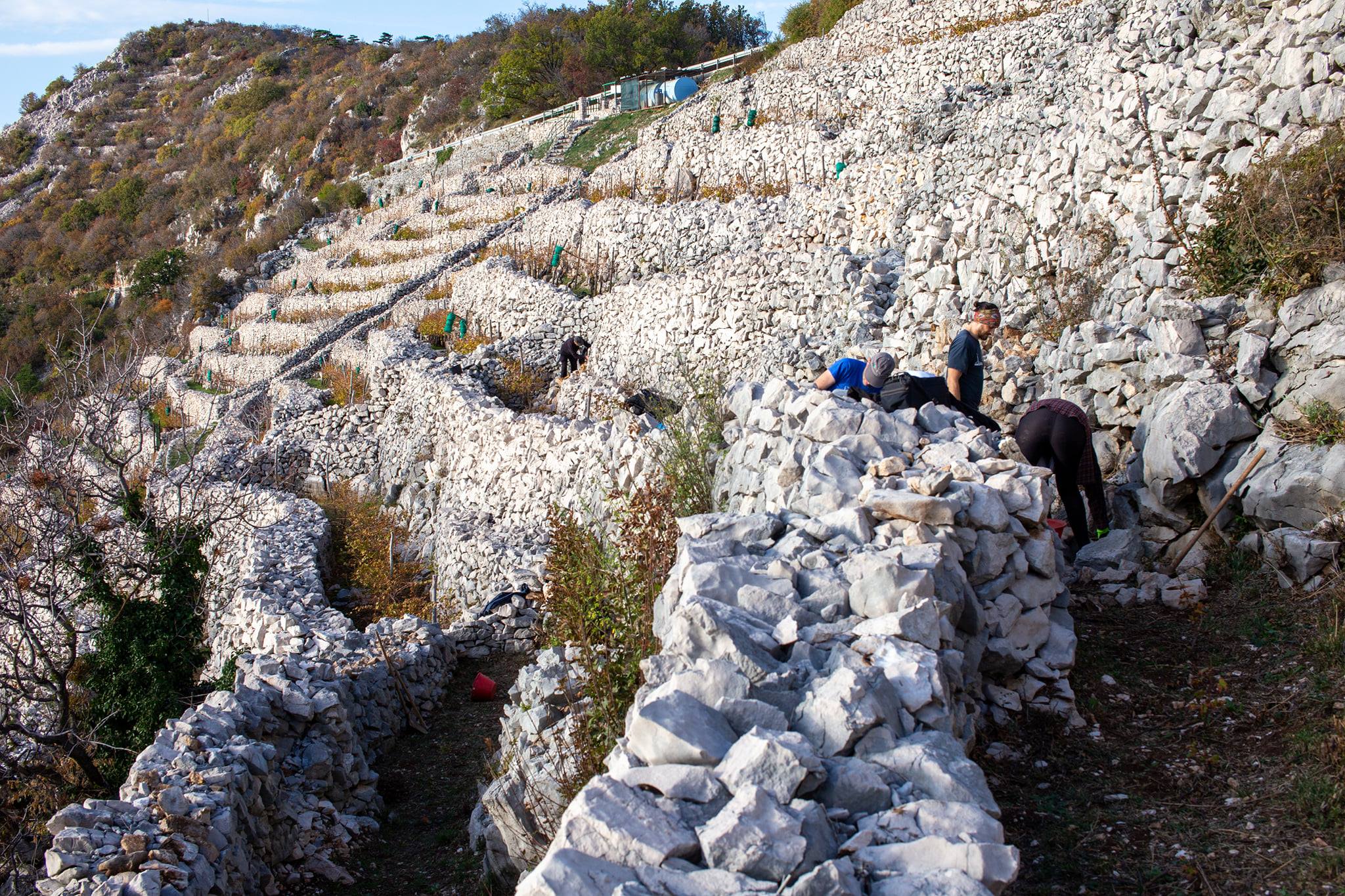 Praputnjak - kulturni krajolik Facebook
Praputnjak - kulturni krajolik Facebook
With Bakar eager to shed its industrial image, efforts are being made to restore the charming town to its former glory. There’s been a noticeable shift towards tourism in recent years; significant investments are being made in public infrastructure, the historic Hotel Jadran is reopening later this year as a four-star facility, and tourism professionals are developing new attractive ways to showcase the vibrant heritage of Bakar. The iconic sparkling wine, together with the spectacular stone vineyards, is just the cherry on top.
Quotes featured in the article were translated from a feature on the dry stone walls of Bakar written by Vjekoslav Tićak and published in Sušačka Revija.
Croatian Divers Cleaned the Seabed of Plastic, Rubber and Glass in Bakar
November 2, 2021 - As part of the Eco Patrol 2021 - Kvarner, an ecological action of cleaning the seabed in Bakar was held yesterday. This action is of great importance for the town because Croatian divers from different parts of the country took part in the action, and they cleaned the area from Nova Riva to Luka.
As reported by the Bakar Tourist Board, the ecological underwater cleaning campaign was organized by the Diving Promotion Agency in cooperation with the Luben Bakar Maritime Sports Association, the HRVI Nemo-Adriatic Diving Club, and the Marco Polo Diving Center under the auspices of the City of Bakar, the Bakar Tourist Board and the Environmental Protection and Energy Efficiency Fund. support and support of INA dd in order to preserve the beauty and purity of the Adriatic Sea.
"The city of Bakar is very pleased to support various eco-actions and provides support to numerous associations in our city that are very active in cleaning actions, both promenades and underwater, and we regularly participate in the Green Cleaning campaign. Following this, the City of Bakar is investing significant funds in the preparation of various projects, including the long-awaited project of sewerage and collectors, which will soon be implemented and will certainly contribute to improving the quality of the sea in Bakar's bay. It should be emphasized that with the new sea promenade, newly renovated Banj Park, historical tuner, future beach, museum, and numerous projects underway, Bakar is slowly but surely turning its page into an ecologically aware city with facilities that will attract many visitors (...) That is why today's action has a special significance for our city,'' said Tomislav Klarić, Mayor of the City of Bakar.
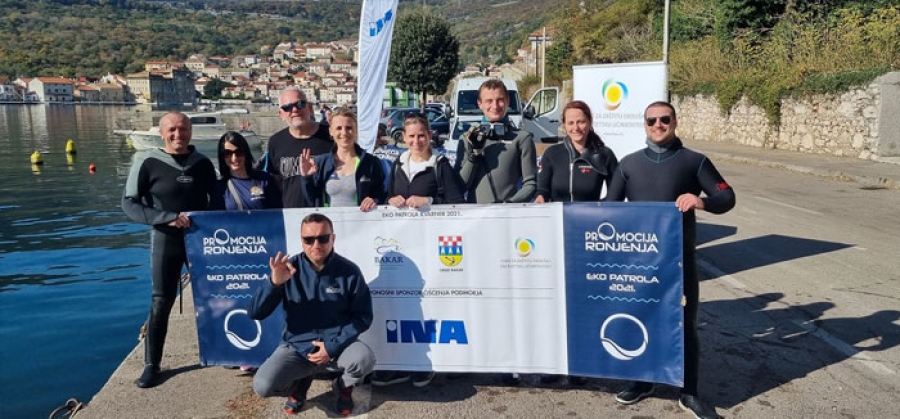
Photo: Bakar Tourist Board
The action was carried out by Croatian divers from different parts of the country in order to remove waste from the sea and reduce the negative impact of waste on marine habitats and raise awareness of the importance of maintaining the cleanliness of the sea and submarine, as well as point the global problem of submarine pollution.
"The Tourist Board of the City of Bakar is making great efforts to valorize the rich cultural, historical and natural heritage of the City of Bakar, so we are always happy to support all types of environmental actions. SPD Luben continuously carries out actions of cleaning the seabed, which is visible in the reduction of waste that is extracted from the sea every year. Unfortunately, many individuals still recklessly throw waste into the sea, without thinking about ecology and what they leave as a legacy for generations to come. I would like to thank all the Croatian divers who participated in today's ecological underwater cleaning campaign and we hope for future successful cooperation with the Diving Promotion in order to contribute to the preservation of our beautiful Bakar Bay. We are glad that many sponsors recognized the value of this initiative and supported the holding of this action, including INA d.d. with whom we have many years of successful cooperation on numerous projects,'' said Sonja Jelušić Marić, director of the Tourist Board of the City of Bakar.
Croatian divers from SPD Luben Bakar, RK HRVI Nemo-Adriatic, DVD Trnje, DC Marco Polo, RK AdriatiCro Jastrebarsko, and DVD Bakar joined the action of cleaning the seabed in Bakar, extracting various waste from the sea, mostly plastic, then tires and glass.
"This is a commendable action of cleaning the seabed, in which we have pulled out from the sea all those things and objects that do not belong there; rubber, glass, plastic. After gathering in front of the SPD Luben, Bakar, we headed to a selected location on the stretch between the new Riva and Luka, where divers in a two-hour action pulled out various waste. We are very happy to participate in all underwater cleaning actions in order to preserve the beauties of our underwater world," said Franjo Vicić, head of the diving section of SPD Luben.
For more, make sure to check out our dedicated lifestyle section.
Is Climate Change Bringing Strange Fish to Northern Adriatic Sea?
June the 28th, 2021 - Climate change is a threat to us all and the vast majority of people are now more than aware of that, minding their carbon footprint and trying to recycle and reuse as much as they possibly can. The Northern Adriatic sea, however, keeps turning up some unexpected finned visitors.
As Morski writes, there are many different types of fish in the Croatian Adriatic sea that are very, very rarely caught, or are not present all over the Adriatic, and so they confuse fishermen with their colours, weight or appearance. Such was the case with the catch of Andrej Andrija Vajdic, whose catch, when placed on social media, resulted in many attempts at determining just what this fish was. Most of those guesses were unfortunately completely wrong.
''After just a few minutes, I got a bite on the line and the fish started pulling down very hard. After a short fight with it, I took it out, and saw a fish I wasn't sure about. I learned that the locals call it an arrow, and it does have that sort of face...''
Here is what Andrej said about his unusual catch in the Northern Adriatic sea:
''As I live in inland Croatia, I'm not often given the opportunity to go sea fishing. I mostly fish only when on holiday, which was the case this year as well. A colleague from work was on holiday in southern Dalmatia at the same time, which was a great opportunity for a little competition - who would catch better fish.
As I was on holiday in Praputnjak, I went fishing in Bakar every day. During the first few days the catch was reduced to standard fish, but on the last day it shifted a bit. At the end of that day, I decided to just go for a short evening and try fishing until the next opportunity came,'' says Andrej.
''I re-set the rod and on the same principle caught three more of the same weird sort of fish. I also learned that the ''arrow'' is usually harder to catch because of its fast movement, which is why this holiday will remain in my special memory. Of course, my colleague undoubtedly lost in our small competition,'' Andrej said.
The fish that Andrej caught is a blue arrow (Trachinotus ovatus, Linnaeus, 1758), a fish from the same family, Carangidae, to which somr of the most famous faces among sea fish belong. It is most numerous in the Southern Adriatic, but due to global warming it is more numerous in the Northern Adriatic sea. Otherwise the blue arrow may grow to a maximum of 70 inches in length.
The first time this species of fish was found was at Zlatni rat on the island of Brac, far from Northern Adriatic sea waters.
For more, follow our lifestyle section.
A Summer of Meaningful Tourism in Bakar
June 18, 2021 - A look at meaningful tourism in Bakar this summer.
The past period has been very challenging for all those associated with tourism, from service providers to travelers themselves. However, according to the well-known proverb that every evil is for something good, the more resourceful ones have successfully used the unpleasant "new normal" situation to create new content and stories. Rumors about one of the (unexpected) winners of the corona crisis prompted us to visit Bakar, a small town on the Kvarner coast.
No giving up
We wanted to experience this newly discovered destination and learn firsthand how the symbol of heavy industry turned into a destination that is being talked about. Even after a short coffee-chat on the romantic Bakar „riva", one can conclude - the locals have not given up. They joke that their ancestors repulsed the Ottoman and Venetian sieges, and defied storms as sailors; thus, they couldn't give up either. They put their heads together (keeping a covid-safe distance, they note) and decided to retaliate against an invisible but ubiquitous enemy with a similar weapon which they have plenty of - intangible but omnipresent history of their town.
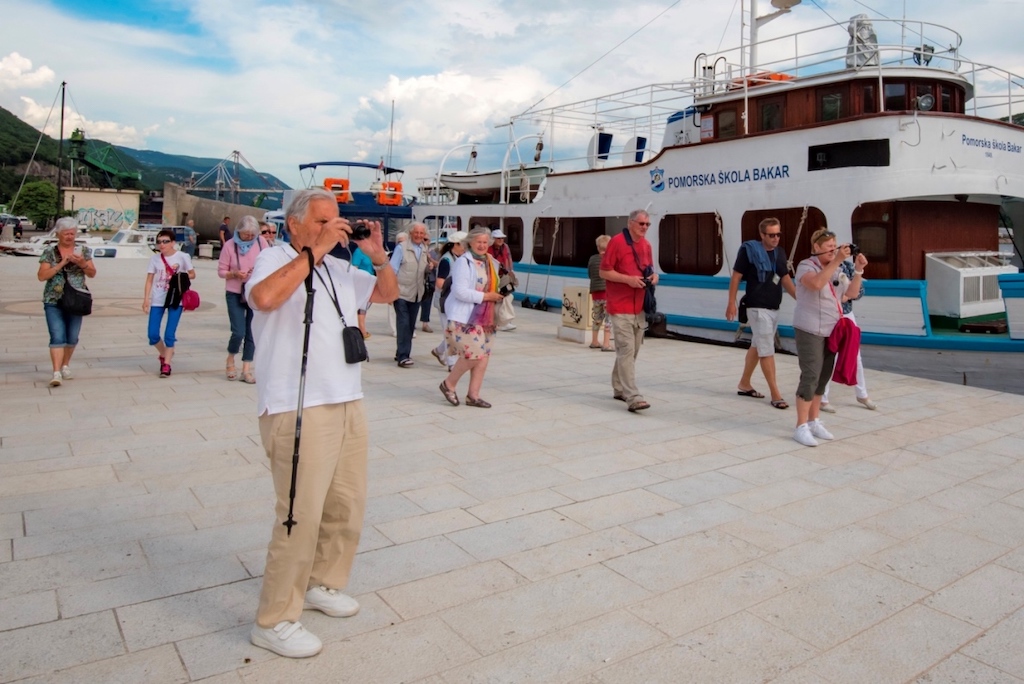
The project called „Baštinska škrinjica" (The Heritage Chest) has turned the local population into digital promotors of the Bakar area. Grandmas were influencing, grandpas couldn't stop sharing, and suddenly, entire local history and natural wonders found their place on social media! What is this lake „now you see me, now you don't"? Didn't know that one of the largest churches in Croatia was there! The National Park Risnjak peak also! Look, just an „ordinary" Bakar bakery sells „Bakarska torta," a traditional cake made by the 150 years old recipe! Have to try it, have to see it!
A good start to the summer
As the reputation of excellence spreads rapidly, this year Bakar picked up two "Simply the Best" awards, and last week its values were recognized in "practice" as well. Before many posh Adriatic destinations, a group of French tourists docked in the ancient Bakar port. One of them, Mr. Pierre Klin, shared his impressions: "This is our first time in Bakar. The program is fantastic! Sailing through the bay, the beautiful old town, the story of the tuna fishery, the hospitality of the hosts. The taste of tuna and sparkling wine with beautiful melancholic music make this trip truly unforgettable."
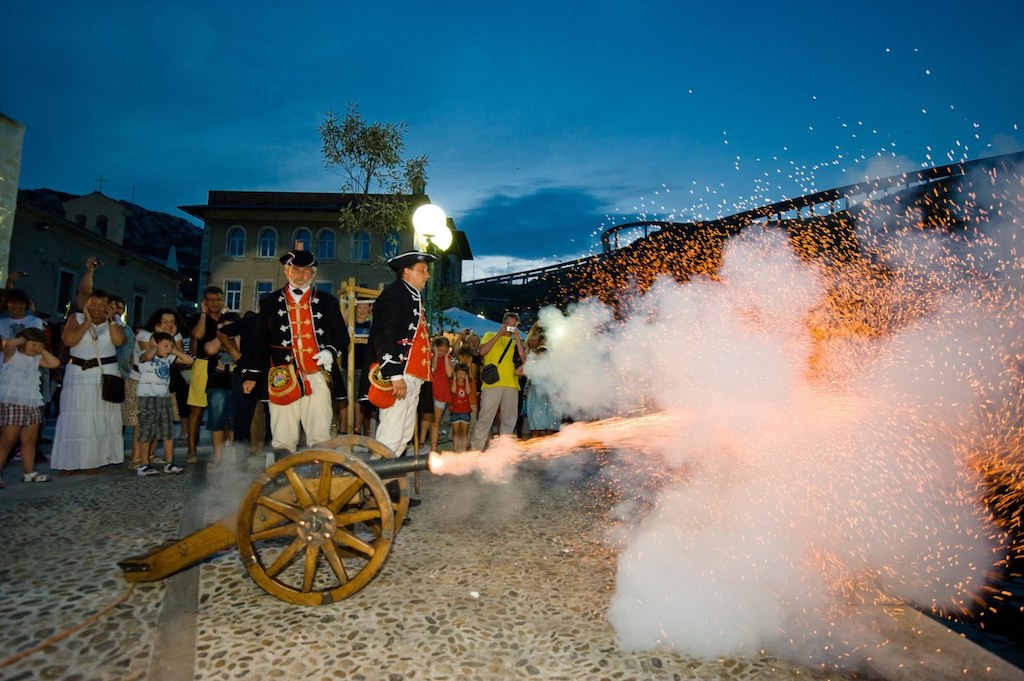
If this made you eager to visit Bakar, don't worry, an opportunity to do it is just around a corner. At the end of June, another „Margaretino leto" (Margaret's Summer) begins. Inspired by the life of the blind waterboy Ivan Čop, who lived in Bakar during the second half of the 19th century, this year's traditional Bakar summer festivity brings us some interesting educational tours and workshops. For instance, visitors will experience „sightseeing" tours while blindfolded. That way, they will discover another dimension of Bakar and get to know the everyday life of the blind as well. As for Bakar, content like this will hopefully position it as one of the Croatian pioneers of contemporary „meaningful tourism." Don't miss it!
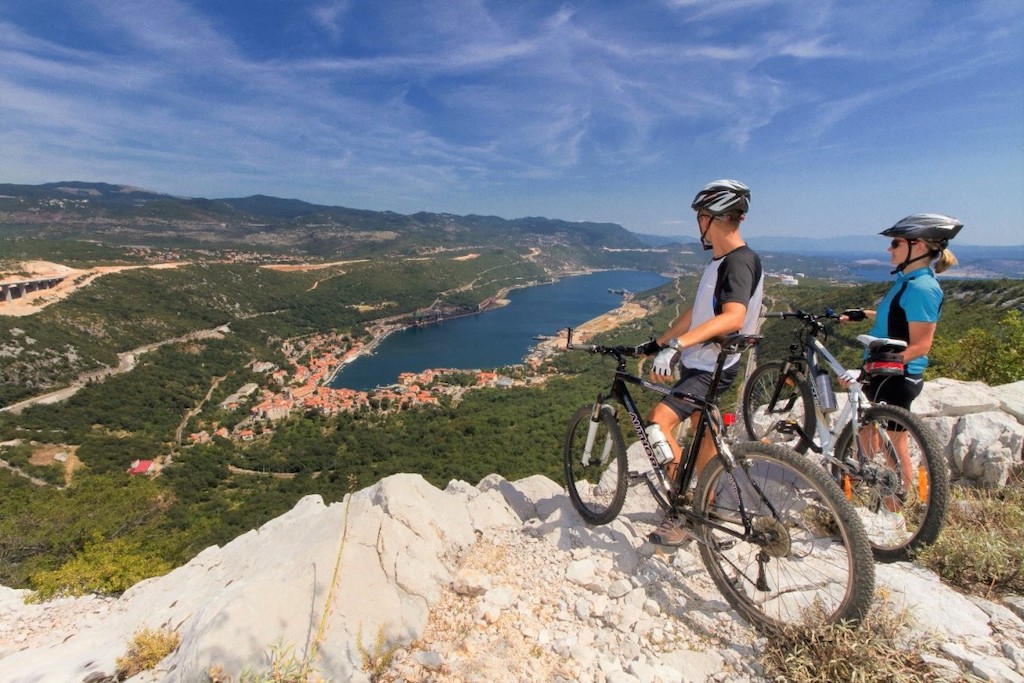
Follow the latest travel updates and COVID-19 news from Croatia HERE.
For more on travel in Croatia, follow TCN's dedicated page.
Bakar Tourist Board ''Heritage Chest'' Project Wins Simply the Best Award
May 30, 2021 - Despite the adversities encountered as a result of the pandemic, the Bakar tourist board has been awarded for its ''Heritage Chest'' project. The goal of the Heritage Chest is to animate the local population in order to collect and preserve valuable heritage material.
As reported by turistickeprice.hr, the tourist board project, designed during the pandemic, called the Heritage Chest, won the national annual award Simply the Best for 2020. This award for creativity, innovation, development, and improvement of the tourist offer of the destination is traditionally given by UHPA (the Association of Croatian Travel Agencies) and the tourist magazine Way to Croatia.
Bakar is an ancient port and one of the oldest cities on the Adriatic. The Mediterranean Sea is the deepest inland right here in the Bakar Bay, which reaches a depth of up to 44 m!
In his arms, Copper proudly ascended the hill like a stone amphitheater. It has been present on the stage of history for 5,000 years, and its core was registered as a cultural monument in 1968. Every step through its streets and surroundings reveals a new, exciting story and unexpected contrasts.
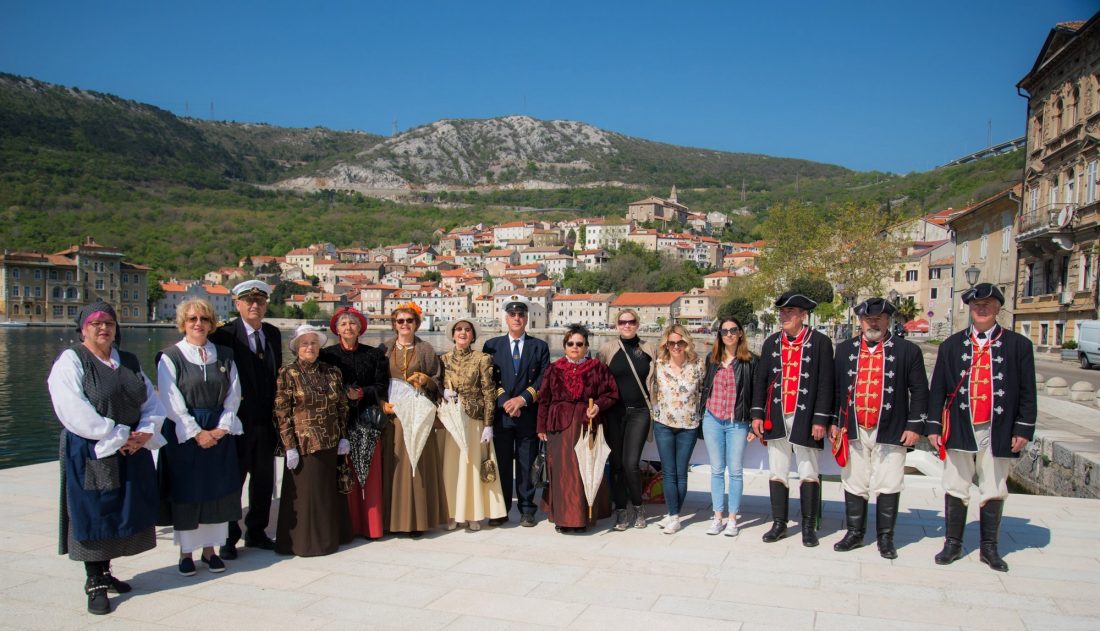
Credit: Bakar Tourist Board Official Facebook Page (Photo by Miljenko Šegulja)
The wider area of the City of Bakar covers as much as 125.60 m2 and unites numerous natural diversity. Bakar and eight surrounding places (Hreljin, Krasica, Kukuljanovo, Plosna, Ponikve, Praputnjak, Škrljevo, and Zlobin), dry stone vineyards of Bakarska prezidi with a praputnjar part called Takala, a karst lake that arises and disappears in Ponikve, Hreljinska Gradina at 321 m above sea level by the sea, the top of the mountain Rišnjak and many other reasons for coming to the Bakar region.
At the time of the pandemic and in very demanding working conditions, in which the tourism sector, in particular, was put to the test, the Tourist Board of the City of Bakar showed its creativity and decorated itself with a valuable award with its innovative project. Two Simply the best awards were won:
- Tourist agency "VIA MEA" won the award in the category ‘‘Travel agency - Cooperation with the local community to improve the tourist offer of the city of Bakar and to develop a new tourist product - heritage gastronomic event Tuna fest’’
- Heritage Chest won the award in the category ‘‘New project in tourism for excellence, creativity, and improvement of the tourist offer of the destination’'.
The Heritage Chest project arose from the need to continue working despite the consequences of the epidemic and in a creative way, with the support of the local community, to overcome the problems due to reduced budgets in conditions of difficult tourist functioning. The goal of the Heritage Chest is to animate the local population in order to collect and preserve valuable heritage material.
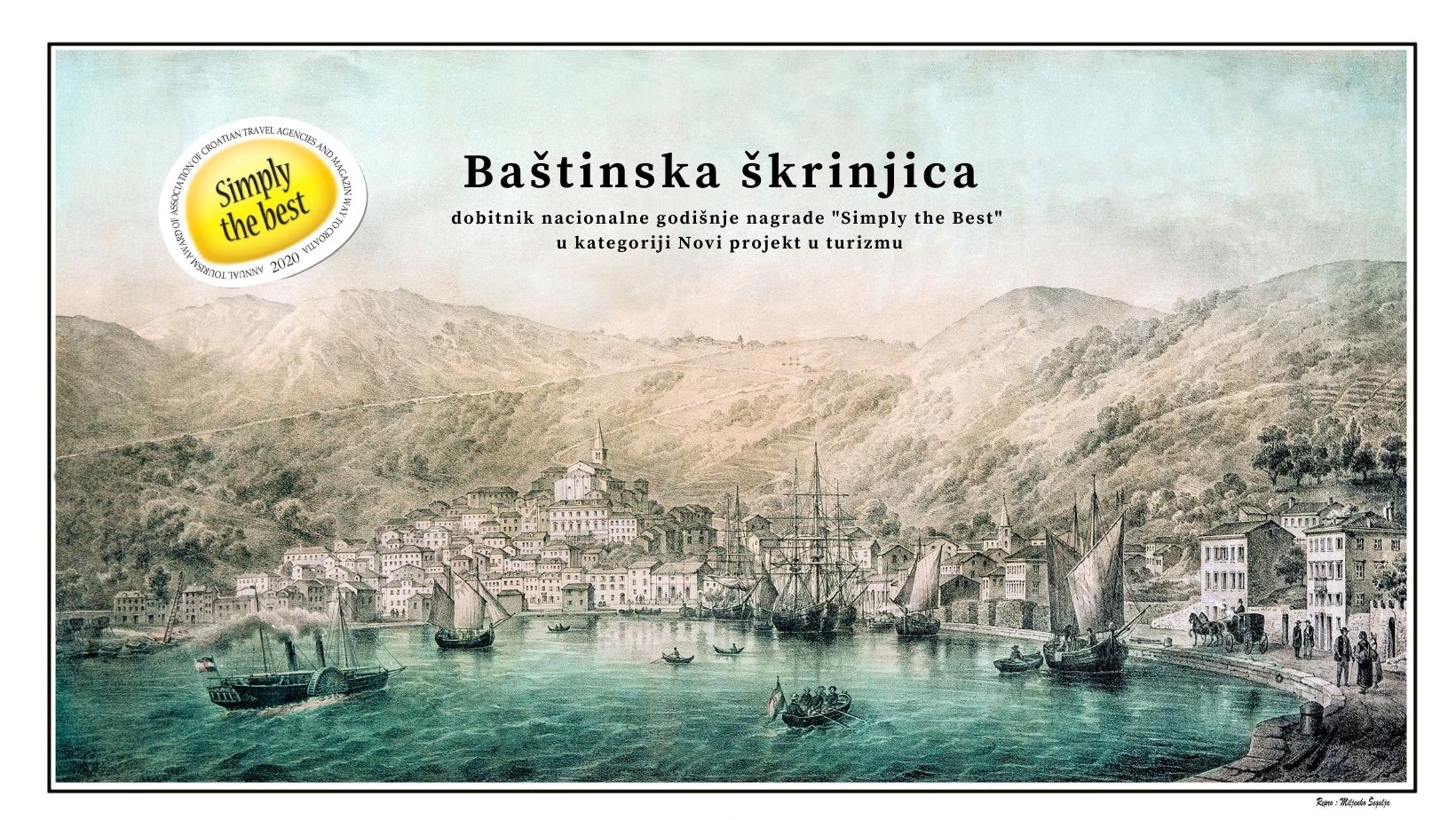
Credit: Bakar Tourist Board Official Facebook Page (Reproduction by Miljenko Šegulja)
Numerous residents and lovers of the Bakar area responded to the invitation of the tourist board by sending it photos, old postcards, author's songs, stories, and interesting records about various historical figures. The casket contains Praputnjarski records and numerous interesting stories, such as the one about the blind copper aquifer Ivan Čop, who lived in Bakar at the end of the 19th century.
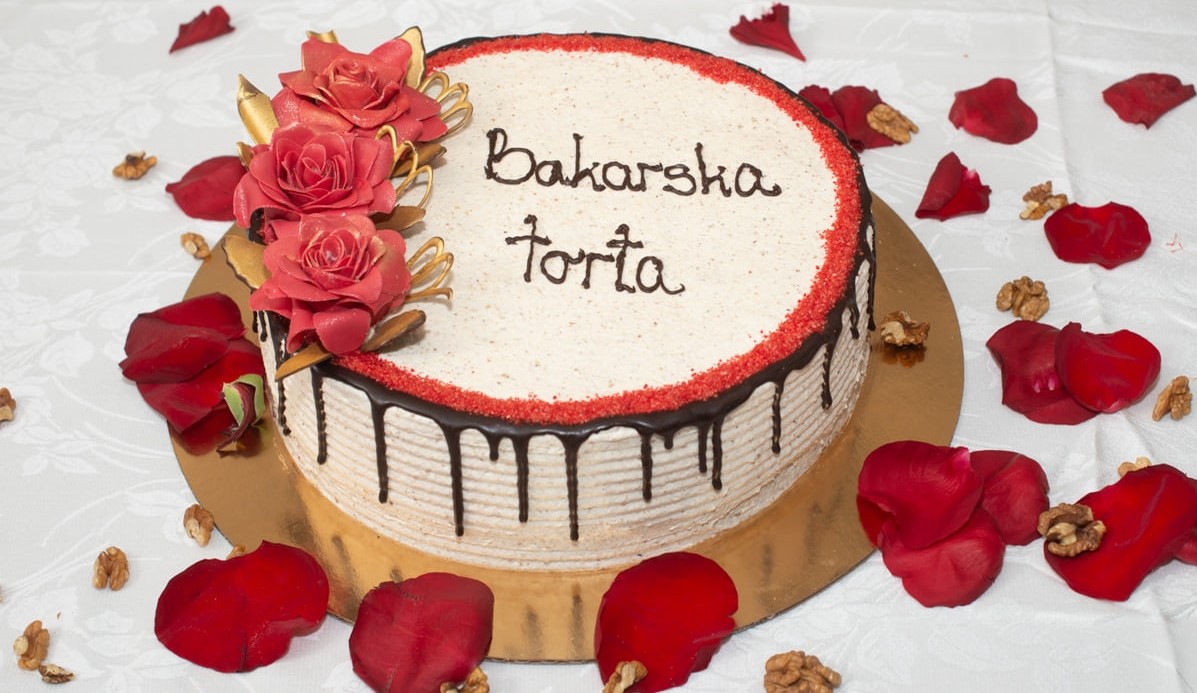
Credit: Bakar Tourist Board Official Facebook Page
The story of the women of the Roberti family from Bakar, who for more than 150 years, from generation to generation, passed on and carefully kept the recipe for the Bakar cake, also found its place in the chest. The Tourist Board of the City of Bakar in cooperation with the bakery "Vrbnik'' managed to revive this recipe and include in its offer Bakar cake: a dessert of sumptuous taste, which further enriched the gastronomic offer of the City of Bakar.
For more about travel in Croatia, follow TCN's dedicated page.
HRK 17.5 Million Set Aside From State Budget To Upgrade Ports in Primorje-Gorski Kotar County
ZAGREB, 11 March, 2021 - Several contracts, worth 17.5 million kuna, for reconstruction of seaports and waterfronts in the broader Rijeka area were signed on Thursday by Sea and Transport Minister Oleg Butković and local authorities.
The contracts envisaging the upgrade of ports on the islands of Krk, Rab and Lošinj as well as the coastal cities of Bakar, Mošćenička Draga, Novi Vinodolski, Crikvenica and Kraljevica are part of the Croatian Coast Renaissance project in which two billion kuna has been invested to date, and the lion's share of this amount has been ensured from EU funds.
Minister Butković said today that investments in seaport infrastructure would continue.
(€1 = HRK 7.582776)
For more about politics in Croatia, follow TCN's dedicated page.
Bakar Tourist Board Wins Prestigious Golden Interstas 2020 Award
As Morski writes on the 17th of October, 2020, the Bakar Tourist Board has won the prestigious international GOLDEN INTERSTAS 2020 tourist award, thus securing its place in the international club of meritorious tourism.
Encouraged by many years of effort and activities of the Bakar Tourist Board, and at the initiative of Mr. Sime Strikoman, the International Commission of Tourist Journalists proposed the candidacy of the Bakar Tourist Board for the prestigious international tourism award. The Bakar Tourist Board was clearly responsible for some highly creative professional achievements and excellence in the presentation of the richness of its tourism, traditional values and culture of Bakar despite all this year's problems with the ongoing coronavirus pandemic.
''We're extremely proud of winning the GOLDEN INTERSTAS 2020 award for excellence in tourism. This award is a great recognition to our entire team and a crown for all the effort and enthusiasm invested in everything we do, which ultimately led to winning this award. On this occasion, I'd like to thank all my associates who participated in the construction of our tourist story and who, with their dedication and professionalism, contributed to winning this valuable award, which is just a confirmation that when working with your heart, results can't be missed,'' said the director the Bakar Tourist Board, Sonja Jelusic Maric.
The 27th INTERSTAS / International Festival of Tourism, Tourist Film, Landscape - International Club of Meritorious for Tourism, will be held, in accordance with epidemiological measures introduced as a result of the pandemic on the 11th, 12th and 13th of November in Solin. The entire event, the presentation of the Laureates and accompanying events, is supported by FIJET, FEST, ITCO, AEFP, CiB / world and European associations in tourism, tourism journalism, film and landscape, under the auspices of the Split-Dalmatia County and of Solin, and under the high auspices of the Croatian Parliament and the President of the Republic of Croatia, Zoran Milanovic.
For the latest travel info, bookmark our main travel info article, which is updated daily.
Read the Croatian Travel Update in your language - now available in 24 languages
Margareta's Summer 2019 Started in Bakar
We've recently written several articles about the re-birth of tourism in the Northern Croatian town of Bakar, and this weekend Total Croatia News got the opportunity to visit Bakar and see for ourselves what exactly is going on there, for the opening of the Margareta's Summer 2019.
I was born and raised in Croatia, and when I was a kid my family had a summer home in Crikvenica (Bakar is located some 20 or so kilometres north of Crikvenica, right near the southern Rijeka suburbs). The road we took to Crikvenica from Zagreb back then went very close to Bakar, and yet I don't remember ever stopping there. There was no reason to: it was a bay, admittedly you could understand how it used to be a nice bay, but it was completely taken over by a coke plant (no, not that kind of coke, the fuel kind). The plant, the port built to support it and other industrial complexes by Ina were built in the bay in the mid-seventies, and have completely ruined any chance for the area to have any meaningful tourist impact (or nature, for that matter; the seventies factories were nowhere near eco-friendly, and reaped havoc in the vicinity). In 1995 the plant was thankfully closed, the ugly chimney was taken down, the area of the Bakar bay started getting some color back and that's exactly when dreams of bringing tourists, and not the heavy industry to the Bay started.
20-something years later, the plans seem to have worked. When I arrived at Bakar yesterday, there was almost no sign of what was happening here in the last half-century (there's still a port). If you didn't know about the coke, there's literally nothing that would ever give you any hint that's what has occupied the bay for decades. I was there for the beginning of the Margaretino Leto 2019 (Margareta's Summer; St. Margaret is the patron-saint of Bakar), a month-long series of events organized by the Bakar Tourist Board each summer, which includes the Naval Battle reconstruction in the bay.
The Naval Battle reconstruction memorializes the event fro 1616, when the Venetiants tried to take over the town of Bakar, attacking with over 20 boats, but brave defenders of the area managed to fight them off, even though they managed to disembark from their boats! That event will be happening this year on the evening of July 13th, and we were there for the other event that aims to celebrate the history of Bakar, "The Walk through History - the Maria Theresa Times". Maria Theresa was the only female ruler of the Habsburg dominions, who in 1779 pronounced Bakar to be a "free royal city", giving it an important position within her kingdom. To celebrate that event, the Tourist Board organized the interpretation walking tour, during which the tourist guide Marjeta Trkman Kravar "became" Maria Theresa and brought to life how important her decision was for Bakar and the area. Baroque music, baroque carriages, local associtations recreating the atmosphere, sweets made using the period-appropriate recipe book from Vienna, chocolate shaped like the document that gave Bakar its freedom, Bakarska Vodica sparkling wine made in the region... All of those things were offered at the begining of the festivities called Margareta's Summer, inviting visitors to come to the ancient town and the old Frankopan Castle in its centre.
Revived Tuna Fishing Story Brings Visitors Back to Bakar
Most places on the Croatian coast would think that a day which includes almost a thousand visitors in a single day is basically a slow one. That does not apply for Bakar, a currently sleepy town between Rijeka and Crikvenica, burdened by the industrial past that has recently been waking up and trying to find their tourist niche and attract as many guests as possible in the pre and post- season.
So, for this past May 1st holiday their Tourist Board, their partners from Via Mea agency from Crikvenica and Papageno from Austria organized a visit by over 200 guests from Austria, who came to experience the "Tuna Fest" in The Bay.
The program of the Tuna Fest is filled with experiences for the guests, who have arrived at Bakar by boat from Kraljevica, which gave them the chance to experience Bakar from the most exciting point of view: from the sea. Then they're introduced to what life was like in the past here, they get to walk around in the Old Town and Frankopan's castle and then proceed to the pier, where they're offered numerous products by the local producers, such as honey, lavender and similar souvenirs. Then a demonstration of the techniques for the tuna fishing is presented – and Bakar Bay used to be the location where the most tuna fish were caught in the Adriatic before the industry took over the bay.
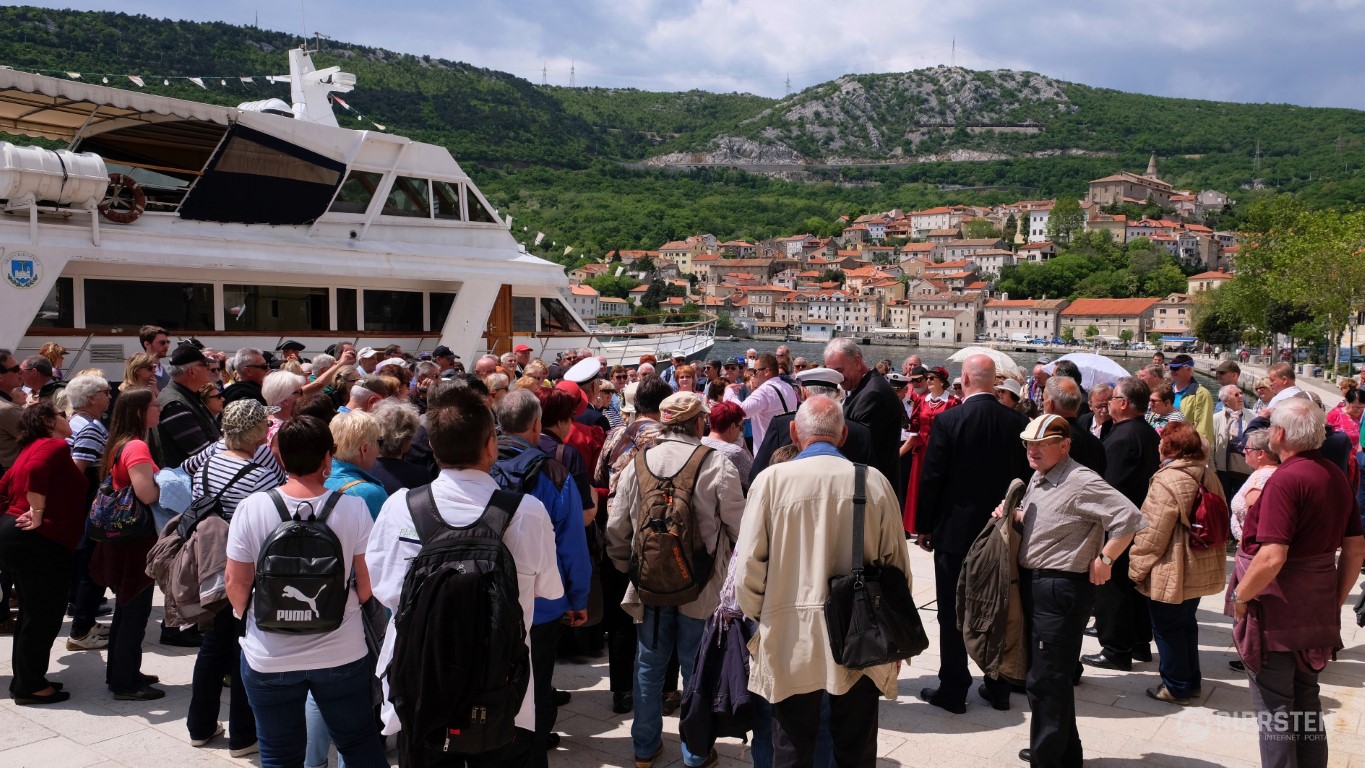
Recently, the tuna have been making their comeback to the Bakar bay, proving that the town and the bay have almost completely recovered from the damage the industry has done there in the past. In front of them, the specialities made with tuna are prepared for their lunch. This week, the group of senior Austrian tourists enjoyed the wonderful weather to improve their experience even further. More than 50 people in Bakar are participating in the organization of these events, and they're hoping that it will increase the number of visitors to their town. Currently, there are over 500 beds for rent in the town, so it can't rely solely on the results during the high tourist season, so bringing groups similar to this one from Austria and Germany, which are quite close to Bakar is an important step in the story of reviving Bakar as a tourist destination.


